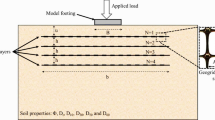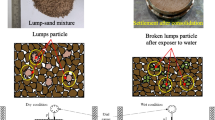Abstract
Very often it is difficult to develop mechanistic models for pavement geotechnical engineering problems due to its complex nature and uncertainty in material parameters. The difficulty in mechanistic analysis has forced the engineers to follows certain empirical correlations. The artificial neural network (ANN) is being as an alternate statistical method, mapping in higher-order spaces, such models can go beyond the existing univariate relationships. The applications of ANNs in pavement geotechnical engineering problems is mostly limited to constitutive modeling, with few applications on prediction of soil layer properties using Falling Weight Deflectometer (FWD), prediction of swelling potential and compute the remaining life of flexible pavements. However, ANN is considered as a ‘Black box’ system being unable to explain interrelation between inputs and output. The ANNs also have inherent drawbacks such as slow convergence speed, less generalizing performance, arriving at local minimum and over-fitting problems. Recently support vector machine (SVM) is being used due to its, better generalization as prediction error and model complexity are simultaneously minimized. SVM is based on statistical learning theory unlike ANNs (biological learning theory). The application of SVM in pavement geotechnical engineering is very much limited and to best of the knowledge such methods have not been applied to pavement geotechnical engineering. However, engineering application of numerical methods is a science as well as an art. This juxtaposition is based on the fact that even though the developed algorithms are based on scientific logic and belong to the special branch of applied mathematics, their successful application to new problems is problem oriented and is an art. As no method can be the panacea to solve all problems to the last details, their application to new areas needs critical evaluation. With above in view, an attempt has been made to develop the art of applying the above artificial intelligence techniques (ANN and SVM) to different pavement engineering problems such as prediction of compaction characteristics, permeability, swelling potential, coefficient of subgrade reaction etc. The parameters associated with the model developments are discussed in terms of guide line for its future
Access this chapter
Tax calculation will be finalised at checkout
Purchases are for personal use only
Preview
Unable to display preview. Download preview PDF.
Similar content being viewed by others
References
Abdallah, I., Ferregut, C., Nazarian, S., Melchor Lucero, O.: Prediction of remaining life of flexible pavements with artificial neural network models. In: Tayabji, S.D., Lukanen, E.O. (eds.) Nondestructive testing of Pavements and Backcalulcation of Moduli, ASTM, STP, 1375, vol. 3, pp. 484–498 (2000)
Abdujauwad, S.N.: Swelling behaviour of calcareous clays from the Eastern Provinces of Saudi Arabia. Quarterly Journal of Engg. Geology 27, 333–351 (1994)
Abdujauwad, S.N., Al-Sulaimani, B, Sl-Buraim: Response of structure to heave of expansive soil. Geotechniques (1994)
Aciroyd, L.W., Husain, R.: Residual and Lacustrine black cotton soil of North- East Ni-geria. Geotechnique, 113–118 (1986)
Basheer, I.A.: Empirical modeling of the compaction curve of cohesive soil. Canadian Geotechnical Journal 38(1), 29–45 (2001)
Boser, B.E., Guyon, I.M., Vapnik, V.N.: A training algorithm for optimal margin classifier. In: The proceedings of the Fifth Annual ACM Workshop on Computational Learning theory, Pittusburgh, PA, USA, July 27–29 (1992)
Cortes, C., Vpanik, V.N.: Supportvector networks. Machine Learning 20(3), 273–297 (1995)
Cristianini, N., Shawe-Taylor, J.: An introduction to Support vector machine. Cambridge University Press, London (2000)
Dakhsnamurthy, Raman: A simple method of identifying expansive soil. Soils and Foundation 13(1), 97–104 (1973)
Das, B.M.: Principles of Geotechnical Engineering. Brookes- Cole, New York (2002)
Das, S.K.: Application of genetic algorithm and artificial neural network to some geotechnical engineering problem, Ph.D Thesis submitted to Indian Institute of Technology, Kanpur, India (2005)
Das, S.K., Basudhar, P.K.: Undrained lateral load capacity of piles in clay using artificial neural network. Computer and Geotechnics 33(8), 454–459 (2006)
Demuth, H., Beale, M.: Neural Network Toolbox. The Math Works Inc., USA (2000)
Ghaboussi, J.: Potential application of neuro-biological computational models in geotechnical engineering. In: Pande, G.N., Pietruszezak, S. (eds.) Numerical models in geomechanices, Balkemma, Rotterdam, The Netherlands, pp. 543–555 (1992)
Gill, W.R., Reaves, C.A.: Relationships of Atterberg limits and cation-exchange capacity to some physical properties of soil. Soil Sci. Soc. Am. Proc. 21, 491–494 (1957)
Goh, A.T.C.: Probabilistic neural network for evaluating seismic liquefaction potential. Canadian Geotechnical Journal 39, 219–232 (2002)
Goh, A.T.C., Kulhawy, F.H., Chua, C.G.: Bayesian neural network analysis of undrained side resistance of drilled shafts. J. of Geotech. and Geoenv. Engineering, ASCE 131(1), 84–93 (2005)
Gourley, C.S., Newill, D., Shreiner, H.D.: Expansive soils: TRL’s research strategy. In: Proc. 1st Int. Symp. on Engineering Characteristics of Arid Soils (1993)
Gray, C.W., Allbrook, R.: Relationships between shrinkage indices and soil properties in some New Zealand soils. Geoderma 108(3-4), 287–299 (2002)
Gualtieri, J.A., Chettri, S.R., Cromp, R.F., Johnson, L.F.: Support vector machine classifiers as applied to AVIRIS data. In: The Summaries of the Eighth JPL Airbrone Earth Science Workshop (1999)
Holtz, W.G.: Expansive clays—properties and problems. Q. Colo. Sch. Mines 54(4), 89–117 (1959)
Ilonen, J., Kamarainen, J.K., Lampinen, J.: Differential Evolution training algorithm for feed-forward neural network. Neural Processing Letters 17, 93–105 (2003)
Jones, D.E., Holtz, W.G.: Expansive soils – The hidden disaster. Civil Engineering ASCE 43(8) (1973)
Liong, S.Y., Lim, W.H., Paudyal, G.N.: River stage forecasting in Bangladesh: neural network approach. Journal of Computing in Civil Engineering 14(1), 1–8 (2000)
MathWork, Inc.: Matlab user’s manual. Version 6.5. Natick, The MathWorks, Inc., MA (2001)
McCormack, D.E., Wilding, L.P.: Soil properties influencing swelling in Canfield and Geeburg soils. Soil Sci. Soc. Am. Proc. 39, 496–502 (1975)
Meier, R.W., Rix, G.J.: Backcalculation of flexible pavement moduli using artificial neural networks. In: Transportation research record, 1448, TRB, National Research Council, Washington, DC, pp. 75–82 (1994)
Morshed, J., Kaluarachchi, J.J.: Parameter estimation using artificial neural network and genetic algorithm for free-product migration and recovery. Water resource research AGU 34(5), 1101–1113 (1998)
Najjar, M.Y., Basheer, I.A., McReynold, R.: Neural mod ing of Kansas soil swelling. Transportation Research Record (1526), 14–19 (1996)
Nelsonm, J.D., Miller, D.J.: Expansive Soils: Problem and Practice in Foundation and Pavement Engineering. Wiley, New York (1992)
Okasha, T.M., Abdujauwad, S.N.: Expansive soil in Al-Madinha. Saudi Arabia. Quarterly Journal of Engg. Geology 27, 333–351 (1994)
Park, D., Rilett, L.R.: Forecasting freeway link ravel times with a multi-layer feed forward neural network. Computer Aided Civil and infastructure Engineering 14, 358–367 (1999)
Parker, J.C., Amos, D.F., Kaster, D.L.: An evaluation of several methods of estimating soil volume change. Soil Soc. Am. J. 41, 1059–1064 (1977)
Haykin, S.: Neural Networks. A Comprehensive Foundation. Prentice Hall, Englewood Cliffs (1999)
Samui, P.: Slope stability analysis: a support vector machine approach. Environ. Geol. 56, 255–267 (2008)
Savana, G.S., Rajan, C.R., Srinivasan, B.S., Subrahmanyam, N., Sampathkumar, T.S.: Swelling Characteristics of Black cotton soils of Karnatak. In: Proc. CBIP, 47th Research Session, vol. 3, pp. 109–111 (1978)
Scholkopf, B.: Support vector learning. R. Oldenbourg, Munich (1997)
Seed, H.B., Woodward, J.R., Lundgren, R.J.: Prediction of swelling potential for compacted clays. J. Soil Mech. Found. Div., Am. Soc. Civ. Eng. 88 (SM3), 53–87 (1963)
Shahin, M.A., Maier, H.R., Jaksa, M.B.: Predicting settlement of shallow foundations using neural network. Journal of Geotechnical and Geoenvironmental Engineering ASCE 128(9), 785–793 (2002)
Smola, A.J., Scholkopf, B.A.: A tutorial on support vector regression. Statistics and Computing 14, 199–222 (2004)
Storn, R., Price, K.: Differential Evolution- A simple and efficient adaptive scheme for global optmization over continuous spaces, Technical Report TR-95-012, International Computer Science Institute, Berkeley, CA, USA (1995)
Thissen, U., Pepers, M., Ustuna, B., Melssena, W.J., Buydensa, L.M.C.: Comparing support vector machines to PLS for spectral regression applications. Chemom. Intell. Lab. Syst. 73(3), 169–179 (2004)
Vapnik, V.: Statistical learning theory. Wiley, New York (1998)
Vapnik, V.: The nature of statistical learning theory. Springer, New York (1995)
Yule, D.F., Ritchie, J.T.: Soil shrinkage relationships of Texas vertisols: 1 small cores. Soil Sci. Soc. Am. J. 44, 1285–1291 (1980)
Author information
Authors and Affiliations
Editor information
Editors and Affiliations
Rights and permissions
Copyright information
© 2009 Springer-Verlag Berlin Heidelberg
About this chapter
Cite this chapter
Samui, P., Das, S.K., Sitharam, T.G. (2009). Application of Soft Computing Techniques to Expansive Soil Characterization. In: Gopalakrishnan, K., Ceylan, H., Attoh-Okine, N.O. (eds) Intelligent and Soft Computing in Infrastructure Systems Engineering. Studies in Computational Intelligence, vol 259. Springer, Berlin, Heidelberg. https://doi.org/10.1007/978-3-642-04586-8_11
Download citation
DOI: https://doi.org/10.1007/978-3-642-04586-8_11
Publisher Name: Springer, Berlin, Heidelberg
Print ISBN: 978-3-642-04585-1
Online ISBN: 978-3-642-04586-8
eBook Packages: EngineeringEngineering (R0)




